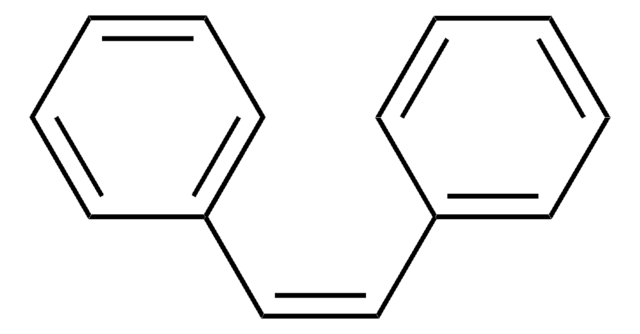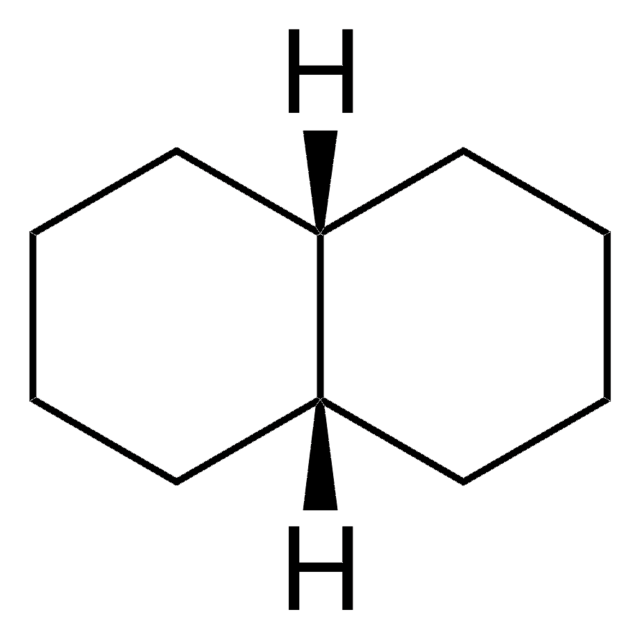Alle Fotos(1)
Wichtige Dokumente
161306
1,8-Nonadiyn
98%
Anmeldenzur Ansicht organisationsspezifischer und vertraglich vereinbarter Preise
Alle Fotos(1)
About This Item
Lineare Formel:
HC≡C(CH2)5C≡CH
CAS-Nummer:
Molekulargewicht:
120.19
EG-Nummer:
MDL-Nummer:
UNSPSC-Code:
12352100
PubChem Substanz-ID:
NACRES:
NA.22
Empfohlene Produkte
Qualitätsniveau
Assay
98%
Form
liquid
Brechungsindex
n20/D 1.449 (lit.)
bp
55-55.5 °C/13 mmHg (lit.)
mp (Schmelzpunkt)
−21 °C (lit.)
Dichte
0.799 g/mL at 25 °C (lit.)
Lagertemp.
2-8°C
SMILES String
C#CCCCCCC#C
InChI
1S/C9H12/c1-3-5-7-9-8-6-4-2/h1-2H,5-9H2
InChIKey
DMOVPHYFYSASTC-UHFFFAOYSA-N
Allgemeine Beschreibung
1,8-Nonadiyne undergoes one-step hydrosilylation reaction for attaching acetylene-terminated alkyl monolayers to nonoxidized crystalline silicon surfaces.
Anwendung
1,8-Nonadiyne was used as starting reagent in the synthesis of 2,6-hexadecadiynoic acid, 2,6-nonadecadiynoic acid and 2,9-hexadecadiynoic acid.
Signalwort
Warning
H-Sätze
Gefahreneinstufungen
Eye Irrit. 2 - Flam. Liq. 3 - Skin Irrit. 2 - STOT SE 3
Zielorgane
Respiratory system
Lagerklassenschlüssel
3 - Flammable liquids
WGK
WGK 3
Flammpunkt (°F)
107.6 °F - closed cup
Flammpunkt (°C)
42 °C - closed cup
Persönliche Schutzausrüstung
Eyeshields, Faceshields, Gloves, type ABEK (EN14387) respirator filter
Hier finden Sie alle aktuellen Versionen:
Besitzen Sie dieses Produkt bereits?
In der Dokumentenbibliothek finden Sie die Dokumentation zu den Produkten, die Sie kürzlich erworben haben.
Néstor M Carballeira et al.
Lipids, 41(5), 507-511 (2006-08-29)
The hitherto unknown 2,6-hexadecadiynoic acid, 2,6-nonadecadiynoic acid, and 2,9-hexadecadiynoic acid were synthesized in two steps and in 11-18% overall yields starting from either 1,5-hexadiyne or 1,8-nonadiyne. Among all the compounds 2,6-hexadecadiynoic acid displayed the best overall antifungal activity against both
Benjamin S Flavel et al.
Langmuir : the ACS journal of surfaces and colloids, 29(26), 8355-8362 (2013-06-25)
Poly(ethylene glycol) (PEG) is one of the most extensively studied antifouling coatings due to its ability to reduce protein adsorption and improve biocompatibility. Although the use of PEG for antifouling coatings is well established, the stability and density of PEG
Stephen G Parker et al.
Nature communications, 9(1), 2288-2288 (2018-06-14)
For many normal and aberrant cell behaviours, it is important to understand the origin of cellular heterogeneity. Although powerful methods for studying cell heterogeneity have emerged, they are more suitable for common rather than rare cells. Exploring the heterogeneity of
Yan B Vogel et al.
Nature communications, 8(1), 2066-2066 (2017-12-14)
Predicting or manipulating charge-transfer at semiconductor interfaces, from molecular electronics to energy conversion, relies on knowledge generated from a kinetic analysis of the electrode process, as provided by cyclic voltammetry. Scientists and engineers encountering non-ideal shapes and positions in voltammograms
Janneke Veerbeek et al.
ACS applied materials & interfaces, 9(1), 413-421 (2016-12-10)
Silicon-based solar fuel devices require passivation for optimal performance yet at the same time need functionalization with (photo)catalysts for efficient solar fuel production. Here, we use molecular monolayers to enable electrical passivation and simultaneous functionalization of silicon-based solar cells. Organic
Unser Team von Wissenschaftlern verfügt über Erfahrung in allen Forschungsbereichen einschließlich Life Science, Materialwissenschaften, chemischer Synthese, Chromatographie, Analytik und vielen mehr..
Setzen Sie sich mit dem technischen Dienst in Verbindung.








